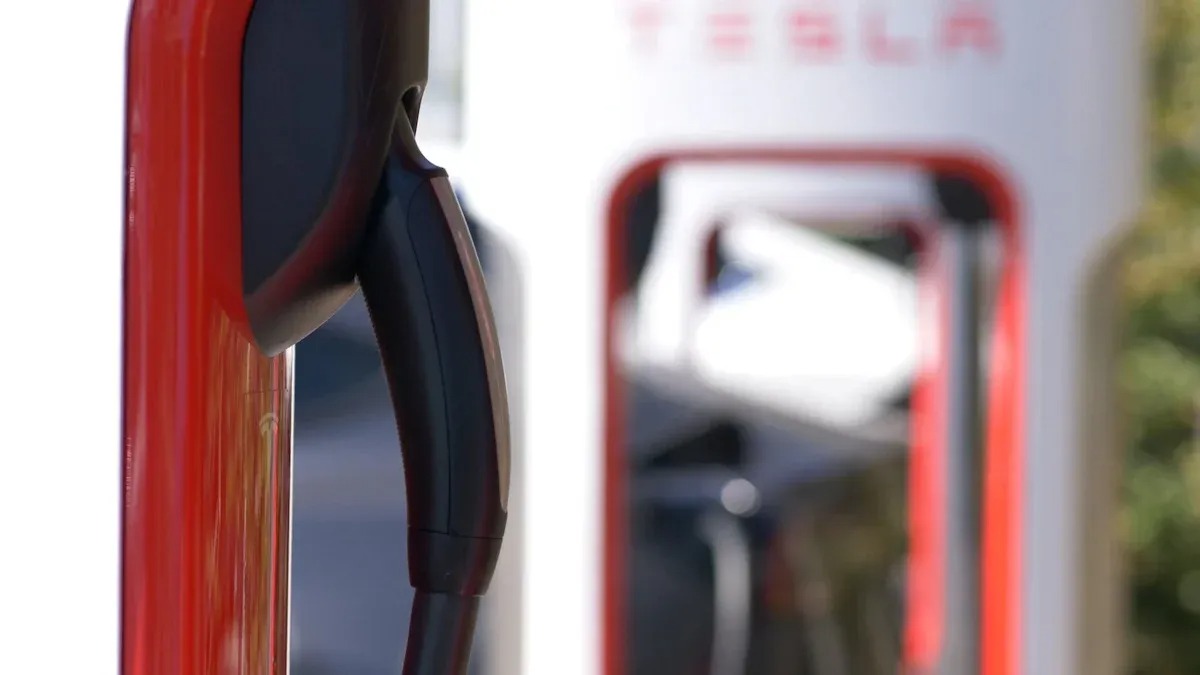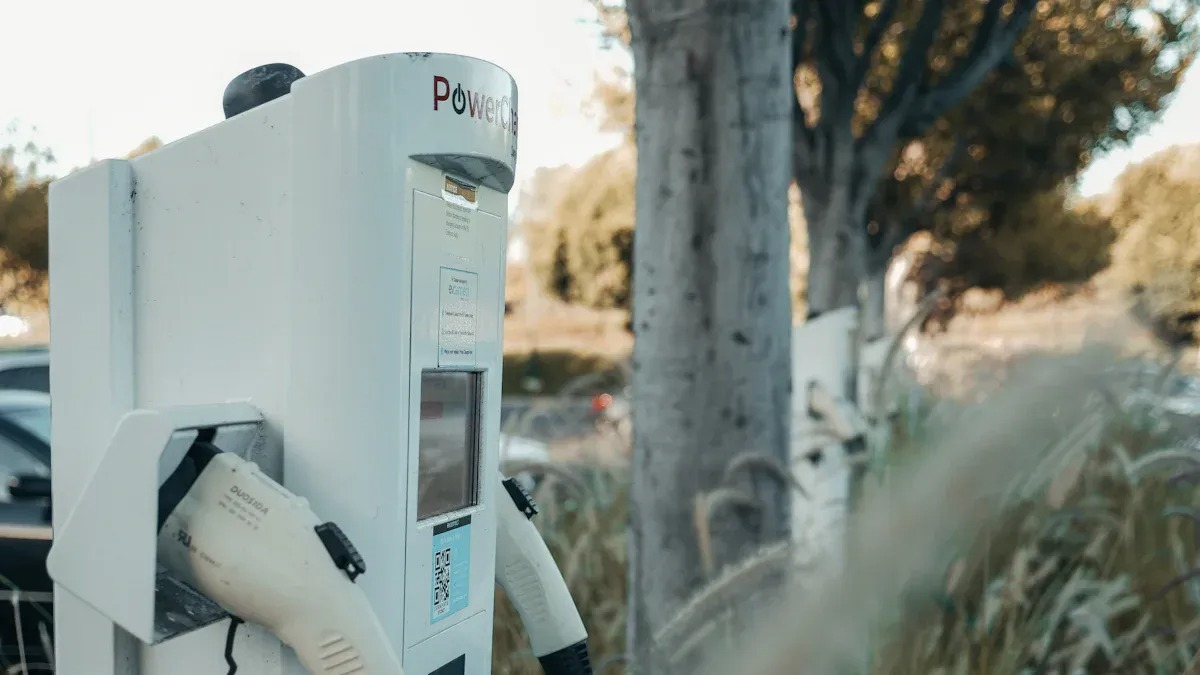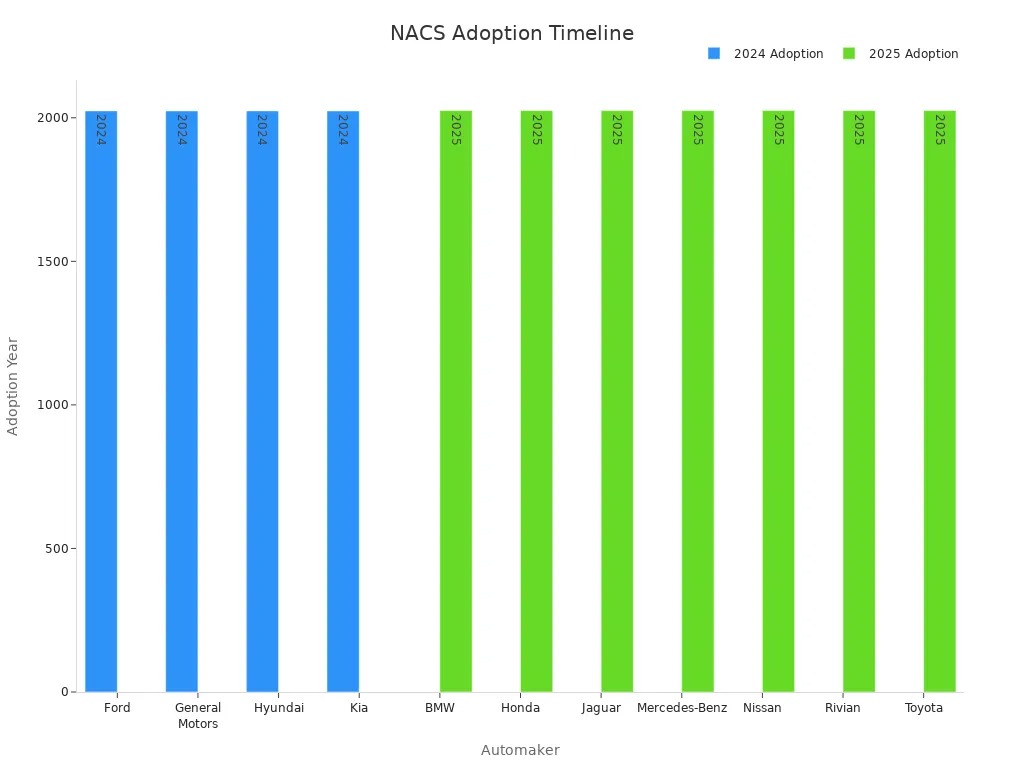If you drive an electric car, understanding EV charging standards is crucial. It helps you select the appropriate method to charge your vehicle. In 2022, there were over 600,000 public slow chargers worldwide. EV charging stations are expanding rapidly, but not all adhere to the same standards. The type of plug can influence how easy or fast the charging process is.
Two main types, NACS and CCS, are popular within the EV charging standards. Each has unique features and operates differently with various cars. These differences impact how quickly and conveniently you can charge your vehicle. Familiarizing yourself with these EV charging standards will enhance your charging experience and ensure your car meets your daily requirements.
Key Takeaways
- Knowing about NACS and CCS is important for EV drivers. Each has special features that impact charging speed and use.
- NACS works mainly with Tesla cars. It has a light, easy-to-use plug and charges quickly using Tesla’s Supercharger network.
- CCS is used worldwide and works with many car brands. It supports both AC and DC charging, making it useful for different EVs.
- To pick between NACS and CCS, think about your car type and nearby charging stations.
- EV charging has a bright future with better technology and government help to improve charging stations and access.
Overview of EV Charging Standards: NACS and CCS
What is NACS?
The North American Charging Standard (NACS) is Tesla’s special charging plug. It was made to give Tesla cars an easy way to charge. The NACS plug is small and light, so it’s simple to use. Tesla’s Supercharger network uses NACS and is very reliable. This network has over 1,800 stations in North America. It provides fast charging for Tesla owners.
NACS is popular because it’s easy to use and Tesla keeps growing its charging network. While mostly used in North America, some carmakers now support NACS or offer adapters. These adapters let other cars use Tesla’s chargers.
What is CCS?
The Combined Charging System (CCS) is a global EV charging standard. Many carmakers around the world support it. It was created in 2012 by seven big car companies. By 2014, the European Union made CCS2 the main standard in Europe.
CCS plugs are bigger than NACS but work in more ways. They can handle both AC and DC charging, making them flexible. By 2016, the U.S. had many CCS stations. Now, there are over 5,200 CCS stations in the country. Carmakers must support CCS to get government funding for EV chargers. This has helped CCS become widely used.
Key differences between NACS and CCS
NACS and CCS are different in design, power, and where they are used. NACS plugs are smaller and lighter, so they’re easier to handle. CCS plugs are bigger and heavier but can charge faster, up to 350 kW. NACS charges up to 250 kW.
Where these plugs are used also differs. NACS is mostly in North America, while CCS is common in Europe. Tesla’s Supercharger network with NACS is seen as more reliable. But CCS works with more car brands, making it a favorite for many.
| Feature | NACS | CCS |
|---|---|---|
| Number of Charging Stations | 1,803 (Tesla) | 5,240 (CCS) |
| Maximum Charging Power | 250 kW | 350 kW |
| Connector Design | Smaller, lighter | Larger, heavier |
| Market Adoption | Mostly North America | Common in Europe |
Both systems have good points. Your choice depends on your car and local chargers.
Design and Usability Comparison
NACS: Small and easy-to-use design
The NACS plug is small and light. Tesla made it to make charging simple. Its size lets you use it with one hand. This makes it very handy for drivers. It also takes up less room in your car’s charging area.
The NACS plug’s simple design helps charging stations too. More plugs can fit in a smaller space. This means more cars can charge at one station. If you like easy and portable options, NACS is a great choice.
CCS: Bigger but more flexible design
The CCS plug is larger and heavier than NACS. But it works with both AC and DC charging. This means you can use it at many types of stations. Its size might feel harder to handle, but it fits more cars.
The CCS plug’s strong build supports faster charging. This can save you time. If you don’t drive a Tesla, you’ll likely use the CCS plug.
Comfort and user experience
How easy charging feels depends on the plug’s design. Problems during charging can cause frustration. For example:
- Drivers feel better when systems give clear updates.
- Saying sorry for issues can make users happier.
The NACS plug is light, so it’s easier to hold. This reduces strain while charging. The CCS plug works with many cars, which can make you feel secure. Both plugs try to make charging better, but they suit different needs.
Charging Speed and Power Capabilities
NACS: Fast charging and flexible voltage
NACS is designed to charge EVs quickly and efficiently. Tesla made it to meet most EV users’ needs. It can charge at speeds up to 350 kW. This means you can add a lot of range fast. The voltage starts at 200 volts and goes up to 1,000 volts. This makes it work with many EV models and charging setups.
| Parameter | Value |
|---|---|
| Minimum Power per Port | 350 kW |
| Minimum Voltage | 200 volts or 250 volts |
| Maximum Voltage | 950 volts or 1000 volts |
These features make NACS a good choice for quick and easy charging. Whether at home or on a trip, NACS is reliable and simple to use.
CCS: Higher power and voltage
CCS can handle very high power levels for charging. It also supports speeds up to 350 kW, like NACS. CCS often works at higher voltages, reaching up to 1,000 volts. This helps it charge bigger batteries faster.
Many public CCS stations offer ultra-fast charging. These are great for long trips when you need to charge quickly. The high voltage also means CCS can work with future EVs that have larger batteries.
Real-world performance comparison
Both NACS and CCS provide fast charging in real life. How well they work depends on the station’s power and your car’s battery. NACS is very reliable, especially with Tesla’s Supercharger network. CCS works with more car brands, making it a good choice for non-Tesla EVs.
When picking between NACS and CCS, think about your car and local chargers. Both systems aim to save you time and make charging easy.
Compatibility with Electric Vehicle Models
NACS: Automakers using it and adapter options
More automakers are starting to use the North American Charging Standard (NACS). This helps cars work better with Tesla’s Supercharger network. It means you can charge easily without needing extra adapters. Big car companies like Ford, General Motors, and Hyundai plan to add NACS plugs to their new electric cars by 2024 or 2025.
For older cars with CCS ports, companies are making adapters. These adapters let your car use Tesla’s charging stations. The table below shows when automakers will start using NACS and offer adapters:
| Automaker | Date | Details |
|---|---|---|
| BMW | Early 2025 | NACS plug standard on 2025 models; adapters for existing CCS vehicles. |
| Ford | Spring 2024 | NACS plug standard on new models; adapters for CCS vehicles. |
| General Motors | 2024 | NACS plug standard on new models; adapters for CCS vehicles. |
| Honda | 2025 | NACS plug standard on 2025 models; adapters for CCS vehicles. |
| Hyundai | Late 2024 | NACS plug standard on new models; adapters for CCS vehicles. |
| Kia | Late 2024 | NACS plug standard on new models; adapters for CCS vehicles. |
| Mercedes-Benz | 2025 | NACS plug standard on 2025 models; adapters for CCS vehicles. |
More automakers using NACS shows a big change in charging standards. This makes it easier to charge your car no matter the brand.
CCS: Works with many car brands
The Combined Charging System (CCS) is still popular because it works with many car brands. It supports both AC and DC charging, making it flexible for drivers. Many carmakers in Europe and North America still use CCS for their cars.
This means you can find CCS charging stations almost anywhere. If you drive a Nissan, Volkswagen, or BMW, CCS is a good choice. Its ability to work with many cars makes it a top option for EV charging.
New trends in EV charging
The EV world is changing fast, with new ideas shaping charging. Automakers and governments want all chargers to work with all cars. Faster charging for bigger batteries is also becoming more common.
The table below shows important trends in EV charging:
| Trend | Description | Impact on EV Industry |
|---|---|---|
| Battery Swapping | People like swapping batteries instead of waiting to charge. | Makes charging quicker and easier for drivers. |
| Smart Charging | Focus on smarter ways to charge cars. | Makes chargers easier to use and find. |
| High-Power Charging | Need for faster charging for big vehicles. | Helps electric trucks and buses work better. |
| Interoperability | Chargers that work with all car brands. | Makes charging simple for everyone. |
| Infrastructure Growth | More money spent on building charging stations. | Gives drivers more places to charge their cars. |
These changes show how the EV industry is working to make charging better. They also help more people switch to electric cars.
Impact on Charging Network Infrastructure
NACS: Tesla’s Supercharger network and future growth
Tesla’s Supercharger network is key to NACS adoption. It gives a fast and reliable charging experience. By October 2023, Tesla added V4 Superchargers with Magic Docks. These let non-Tesla cars charge without adapters. Tesla also added payment terminals to make charging easier.
The network is very dependable, with 99.95% uptime. This means you can charge your car without delays. Tesla plans to add more Superchargers across North America. The company can use $7.5 billion from the NEVI program. This money will help build stations in areas that need them most.
Here’s how Tesla’s Supercharger network helps local communities:
| Metric Description | Findings |
|---|---|
| More Customer Visits | Nearby businesses get more visitors when chargers are present. |
| Increase in Local Spending | Charging stations encourage spending at nearby shops and restaurants. |
| Help for Underserved Areas | Stations improve access and boost local economies in these regions. |
CCS: Bigger network but some reliability problems
CCS networks cover more areas worldwide than NACS. But they often have reliability issues. A California study showed only 72.5% of CCS chargers worked properly. About 25% of stations break down often, frustrating users.
| Study Title | Findings | Source |
|---|---|---|
| California study of fast-chargers | 72.5% of chargers worked; 22.7% had issues | Green Car Reports |
| EV Charging Station Reliability Challenges | 25% of stations often malfunction | Tealcom |
| EV Engineering Webinars | Highlights need for better reliability standards | Charge Devs |
Even with these problems, CCS is still popular because it works with many car brands.
Accessibility and availability for EV drivers
Charging station access depends on where you live. Cities have more stations, but rural areas often lack them. These “charging deserts” make it hard for EV drivers to find chargers. A study of 1 million reviews showed drivers could charge successfully only 78% of the time.
To fix this, more fast chargers are needed in rural areas. Research says 8,000 new stations would cover these regions. Here’s a summary of the current challenges:
| Metric Description | Findings |
|---|---|
| Incomplete Trips | Many trips fail due to no charging stations nearby. |
| Needed Fast Chargers | Hundreds of chargers are required for basic city-to-city coverage. |
| Rural Area Chargers | 8,000 stations are needed for full rural access. |
Adding more charging stations will make EVs easier for everyone to use. As charging standards improve, expect better access and fewer problems.
Future Developments and Implications for EV Charging Standards
NACS: Becoming a universal standard
The North American Charging Standard (NACS) is changing to be widely used. In June 2023, a group started working on making NACS a standard. By December 2023, they will share rules for using the NACS connector. In 2024, carmakers will offer adapters for CCS cars to use NACS. By August 2024, NACS will likely become a recommended standard for all brands.
| Date | Event |
|---|---|
| June 2023 | Group formed to make NACS a standard. |
| Dec 2023 | Rules shared for using the NACS connector. |
| 2024 | Adapters for CCS cars to use NACS will be available. |
| Aug 2024 | NACS becomes a recommended standard for all brands. |
These changes will make NACS easier to use and more common. Soon, you’ll have more charging options and better compatibility.
CCS: Government funding and improvements
The Combined Charging System (CCS) gets strong support from the government. The NEVI program gives $7.5 billion to grow EV charging networks. This money focuses on building more CCS stations. Automakers must support CCS to get government help.
This funding has increased CCS stations quickly. But some chargers still don’t work well. Only 72.5% of CCS chargers work properly. The NEVI program aims to fix these issues. For you, this means better and more reliable charging soon.
New technologies shaping EV charging
New ideas are changing how EVs charge. Solar-powered chargers and battery systems are becoming popular. Robots are being made to charge cars automatically. These tools aim to make charging faster and easier.
- EVs are being added to transportation systems in new ways.
- Smart tools help plan routes and find chargers faster.
- Better energy use and steady power help drivers.
| Aspect | Details |
|---|---|
| Market Growth | Predictions for more chargers in the next 10 years. |
| New Technology | Solar chargers, battery systems, and robot chargers are improving. |
| Megawatt Charging System | Big chargers for trucks and future investments are being developed. |
These updates will make EV charging better and easier for you. They also help create a cleaner and smarter transportation system.
Knowing the main differences between NACS and CCS is important. NACS is small and works well with Tesla’s chargers. CCS fits more cars and can handle higher power levels. Pick based on your car and nearby charging spots.
The future of EV charging is exciting. Car companies and governments aim to make charging easier. New technology will bring faster charging and better stations. Soon, owning an electric car will be simpler and more convenient.
FAQ
1. What is the main difference between NACS and CCS?
NACS is smaller and lighter, made for Tesla cars. CCS is bigger but works with more car brands. Both allow fast charging. NACS uses Tesla’s reliable Supercharger network, while CCS has wider compatibility.
2. Can non-Tesla EVs use Tesla Superchargers?
Yes, Tesla added Magic Docks at some Superchargers. These let non-Tesla cars charge with adapters. Check if your car works with Tesla stations before going.
3. Which charging standard is better for long trips?
Both NACS and CCS are good for long trips. NACS uses Tesla’s large Supercharger network. CCS has more stations worldwide, but some are less reliable. Pick based on your car and travel plans.
4. Are adapters available for switching between NACS and CCS?
Yes, adapters are available from automakers and other companies. They let CCS cars use NACS chargers and the other way around. Adapters make charging at different stations easier.
5. Will one standard dominate in the future?
The EV world is moving toward chargers that work with all cars. NACS is becoming popular with automakers. CCS has strong government support. Both may stay, but one could lead in the future.
Post time: Apr-09-2025




